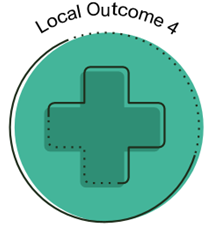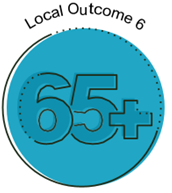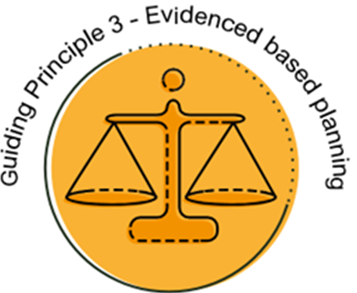Introduction
This Public Performance Report for 2022/23 forms part of our Strategic Planning and Performance Framework and provides a summary of how the Council has delivered services across the reporting year and the impact those services have had on the people and businesses of East Dunbartonshire.
Note: Subtitles can be turned on for the video below by clicking the subtitles/closed captions (cc) button at the bottom of the video.
Local Outcomes Improvement Plan
East Dunbartonshire’s Local Outcomes Improvement Plan (LOIP) is a shared strategic plan for our Community Planning Partnership. It outlines why and how we will work together with our partners to organise and provide services in a way that tackles known inequalities. The LOIP identifies six local outcomes which the Council and our Community Planning partners will seek to deliver with our people and communities.
Our six local priority outcomes are:
- East Dunbartonshire has a sustainable and resilient economy with busy town and village centres, a growing business base, and is an attractive place in which to visit and invest.
- Our people are equipped with knowledge and skills for learning, life and work.
- Our children and young people are safe, healthy and ready to learn.
- East Dunbartonshire is a safe place in which to live, work and visit.
- Our people experience good physical and mental health and wellbeing with access to a quality built and natural environment in which to lead healthier and more active lifestyles.
- Our older population and more vulnerable citizens are supported to maintain their independence and enjoy a high quality of life, and they, their families and carers benefit from effective care and support services.
In order to achieve our vision, there are several guiding principles and approaches to working which are paramount. They lend themselves to the planning and delivering of activities under all of our local priority outcomes.
- Best Value
- Coproduction and engagement
- Evidenced based planning
- Fair and equitable services
- Planning for place
- Prevention and early intervention
- Sustainability
Read the LOIP on the Community Planning in East Dunbartonshire webpage.
Local Government Benchmarking
Councils are required to report on performance information using the Local Government Benchmarking Framework (LGBF) each year and this is reported on the Improvement service website[opens in a new window]
This information enables you to assess and compare how we are performing against other councils across a range of service areas covering: children's services; corporate services; social work services; cultural and leisure services; environmental services; housing services; corporate assets and economic development.
The most recent publication of the LGBF data.
|
Local Government Benchmarking Indicators |
||||
|---|---|---|---|---|
|
|
2020/21 |
2021/22 |
2022/23 |
Scottish Average |
|
Number of Business Gateway start-ups per 10,000 population |
9.7 |
12.3 |
11.3 |
14.3 |
|
Proportion of properties receiving superfast broadband |
97.0% |
97.4% |
98.1% |
95.5% |
|
Claimant Count as a percentage of working age population |
4.1% |
2.9% |
2.0% |
3.2% |
|
Claimant Count as a percentage of 16-24 population |
5.3% |
3.2% |
2.2% |
3.5% |
|
Average time per business and industry planning application (weeks) |
8.7 |
11.1 |
7.4 |
12.0 |
|
Average number of days taken to complete non-emergency repairs |
11.1% |
12.0% |
11.6% |
9.7% |
|
% of people 65+ with long term care needs who are receiving personal care at home |
61.0% |
62.7% |
62.1% |
61.5% |
|
Proportion of adult care services graded good or better |
89.7% |
86.2% |
87.0% |
75.0% |
|
Cost per dwelling of collecting Council Tax |
£10.24 |
£8.93 |
£8.43 |
£6.84 |
|
Sickness absence days per teacher |
3.3 |
5.4 |
5.1 |
6.8 |
|
Sickness absence days per employee (non-teacher) |
8.6 |
12.0 |
13.4 |
13.2 |
|
Percentage of income due from Council Tax received by the end of the year |
96.7% |
97.5% |
97.7% |
96.2% |
|
Percentage of invoices sampled that were paid within 30 days |
94.4% |
93.4% |
92.0% |
90.6% |
|
Percentage of operational buildings that are suitable for their current use |
83.6% |
84.4% |
86.0% |
86.1% |
|
Percentage of internal floor area of operational buildings in satisfactory condition |
92.6% |
92.6% |
88.6% |
89.7% |
|
Proportion of the highest paid 5% of employees who are women |
58.2% |
59.6% |
61.2% |
58.9% |
|
Gender Pay Gap (%) |
5.6% |
3.8% |
4.2% |
2.5% |
|
Gross rent arrears (all tenants) as a percentage of rent due for the year |
12.1% |
12.8% |
11.4% |
9.6% |
|
Proportion of rent due in the year that was lost due to voids |
2.1% |
1.4% |
1.0% |
1.7% |
|
Proportion of council dwellings meeting Scottish Housing Quality Standards |
61.0% |
13.9% |
53.5% |
70.9% |
|
Street cleanliness score |
91.8% |
91.2% |
90.1% |
90.6 |
Jump to section:
- Local Outcome 1
- Local Outcome 2
- Local Outcome 3
- Local Outcome 4
- Local Outcome 5
- Local Outcome 6
- Guiding Principles 1 - Best Value
- Guiding Principles 2 - Coproduction and Engagement
- Guiding Principles 3 - Evidence Based Planning
- Guiding Principles 4 - Fair and Equitable Services
- Guiding Principles 5 - Planning for Place
- Guiding Principles 6 - Prevention and Early Intervention
- Guiding Principles 7 - Sustainability
Local Outcome Improvement Plan
East Dunbartonshire’s Local Outcomes Improvement Plan (LOIP) is a shared strategic plan for our Community Planning Partnership.
Local Outcome 1
 East Dunbartonshire has a sustainable resilient economy with busy town and village centres, a growing base, and is an attractive place in which to visit and invest.
East Dunbartonshire has a sustainable resilient economy with busy town and village centres, a growing base, and is an attractive place in which to visit and invest.
Programmes and services to support business and facilitate sustainable economic growth and business development were delivered throughout 2022/23. These included:
- Economy: The delivery of projects from the Economic Development Strategy ) and Economic Recovery Plan and direct proactive engagement with on-going support to local businesses, through Business Gateway to encourage and support new start business, business growth, and sustainable job creation and inward investment.
- Draft Circular Economy Strategy: A draft Circular Economy Strategy was produced in collaboration with members of East Dunbartonshire Economic Partnership and informed by early engagement activities with the local business community, across Council services and with Community Planning Partners. The Draft Circular Economy Strategy was approved in March 2023.
- Regeneration: Regeneration and Town Centre projects progressed throughout 2022/23 including; design work for Regent Gardens and Union Street, Kirkintilloch, the progression of Twechar Outdoor Pursuits and Training Centre and successful funding for the Campsie Memorial Hall project.
Local Outcome 2
Our people are equipped with knowledge and skills for learning, life and work.
During 2022/23:
- Modern Apprentices: East Dunbartonshire recruited Modern Apprentices in the following departments; Streetscene Environmental, Roads and Civils, Youth Work, Early Years, Building Standards, Operational Procurement and Supply Chain, Communications and Engagement, and two Graduate Apprentices studying for a Masters of Accountancy. Apprentices started in August and are from all over East Dunbartonshire; Twechar, Kirkintilloch, Bearsden, Torrance and Bishopbriggs.
- Construction and Property Programme: Pupils at Douglas Academy took part in a dedicated construction and property programme designed to highlight how young people can pursue a career in the sector. East Dunbartonshire Council teamed up with The Association of Women in Property and contractor McLaughlin & Harvey to run the Schools Outreach Programme. Over eight weeks, 28 S2 pupils gained a unique glimpse into the key stages of the design and pre-construction process, hearing from experts in Architecture, Town Planning, Engineering, Design, Quantity Surveying, Sustainability and Project Management.
- Youth Development Workers: Young people in East Dunbartonshire’s Secondary Schools have benefited from the introduction of dedicated full time Youth Development Workers based in their schools. Working in partnership with Headteachers and teaching staff, Youth Development Workers focus on a variety of youth services, such as employability programmes and well-being to supporting young people disengaging with learning and wider achievement.
Local Outcome 3
Our children and young people are safe, healthy and ready to learn
- Attainment: Performance and overall achievement rates among secondary school pupils continued to be high, as shown in the table below. It should be noted that the figures for 2022 and 2023 include National 5, Higher and equivalent qualifications, previous years information was limited to National Awards.
| Year | Percentage of S4 roll achieving | 2022 Diet | 2023 Diet |
|---|---|---|---|
| S6 Pupils | 1+ SCQF Level 7 (Advanced Higher and equivalent qualifications) | 45.31 | 43.53 |
| 3+ SCQF Level 6 (Higher and equivalent qualifications) | 78.74 | 74.70 | |
| S5 Pupils | 1+ SCQF Level 6 (Higher and equivalent qualifications) | 84.42 | 82.17 |
| 3+ SCQF Level 6 (Higher and equivalent qualifications) | 70.98 | 69.84 | |
| 5+ SCQF Level 6 (Higher and equivalent qualifications) | 49.29 | 50.88 | |
| S4 Pupils | 5+ SCQF Level 5 (National 5 and equivalent qualifications) | 77.05 | 76.96 |
The annual participation measure reports on the activity of the wider 16-19 year old group, including those young people at school. Of those who were participating in education, training or employment.
| Annual Participation Measure Report 2022 | |||
|---|---|---|---|
| Participating in Education, Training or Employment | Not Participating (those unemployed seeking employment and others unemployed and not seeking employment) | Unconfirmed Status | |
| East Dunbartonshire | 96.8% | 1.0% | 2.2% |
| Scotland | 92.3% | 4.0% | 3.6% |
Skills Development Scotland 2022
- Children’s Mental Health and Emotional Wellbeing: During the pandemic the numbers of children and young people seeking support for anxiety and eating disorders increased significantly. In response, the Delivering for Children and Young People Partnership (DCYPP) prioritised improvements in this area. The aim has been to improve early access to mental health, wellbeing and emotional support that is fit for purpose. New funding has been used to develop local pilot projects, including a Compassionate Distress Response Service (aged 16-26) and additional counselling provided by LifeLink to support home schooled children and young people 16+ who are not in school. This service specifically targeted young people referred for support to the Children & Young People Mental Health Services (CAMHS).
Local Outcome 4
East Dunbartonshire is a safe place in which to live, work and visit.
During 2022/23:
- Parking Management Plan: The Parking Management Plan was approved by Council in June 2022 and outlines how parking restrictions are to be enforced. Key policies and actions include; supporting an enhanced electric vehicle charging network, improved sheltered cycle parking, the continued operation and monitoring of pay and display car parks in town centres, embedding the sustainable travel hierarchy in school travel and traffic free school schemes based on the circumstances of individual schools.
- Community Protection: Continued to actively engage in local co-production arrangement with Police Scotland. This resulted in a significant amount of joint work and coordinated activity to protect communities across East Dunbartonshire, with several targeted initiatives being delivered (e.g. in relation to antisocial behaviour, youth disorder, bogus callers, licensing enforcement and parking issues).
- Environmental Health: Were involved in full programmes of inspection and sampling activity in relation to food safety. An annual progress report on standards of Air Quality within East Dunbartonshire was prepared and submitted.
- Community Safety: Community Safety Officers have been engaged in the delivery of services in relation to antisocial behaviour, youth disorder, neighbour disputes, environmental incivilities, dog control, decriminalised parking enforcement, fly-tipping, mediation, CCTV and pest control.
- Trading Standards: A Trading Standards Trusted Trader Scheme was introduced for East Dunbartonshire and work to develop business participation in the scheme is ongoing.
- Joint enforcement work: Trading Standards and Police Scotland worked together on scam and doorstep crime issues continued via Operation Skipjack, with a focus on the protection of our vulnerable and elderly populations from financial harm.
Local Outcome 5
Our people experience good physical and mental health and wellbeing with access to a quality built and natural environment in which to lead healthier and more active lifestyles.
people experience good physical and mental health and wellbeing with access to a quality built and natural environment in which to lead healthier and more active lifestyles.
During 2022/23:
- Active Travel: A major upgrade to a key active travel route between Kirkintilloch and Lennoxtown was delivered. A range of feasibility and design work took place to further develop projects from the Active Travel Strategy in preparation for implementation in following years. These include new active travel routes and upgrades to existing routes, Traffic Free Schools pilot project and the Canniesburn Toll redevelopment project which is expected to the delivered over 2023-2024.
Further information on active travel can be found on the Council's Transport webpage.
- Planning and Building Standards: Over 800 planning applications and over 1,200 building warrant applications were processed and determined during 2022/23. 88% of all householder planning application were decided within two months with an average timescale of 6.9 weeks.
- Enforcement team: Continued to deal with a high number of new cases. A total of 98 cases were taken up and 71 breaches resolved. The majority of cases resolved were done so through the use of negotiation and co-operation avoiding the need for any formal action.
- Free Swimming and Gym Sessions: Between November 2022 and March 2023, all primary school pupils in the area were able to enjoy free swimming while secondary students aged 12-18 could access a range of free gym sessions. The free swimming and gym sessions were available at all three leisure centres - Allander, Kirkintilloch, and the Leisuredrome.
- Attention Deficit Hyperactivity Disorder Assessment Clinic: The Health and Social Care Partnership (HSCP) established a new Attention Deficit Hyperactivity Disorder (ADHD) assessment clinic on a Saturday to enable people to attend out with working or school hours. This has proved popular with clinic attendance rates at 100%.
Local Outcome 6
 Our older population and more vulnerable citizens are supported to maintain their independence and enjoy a high quality of life, and they, their families and carers benefit from effective care and support services.
Our older population and more vulnerable citizens are supported to maintain their independence and enjoy a high quality of life, and they, their families and carers benefit from effective care and support services.
During 2022/23:
- Local Area Coordinators: The Health and Social Care Partnership (HSCP) established two new Local Area Coordinator posts to support employment initiatives for adults affected by learning disability, learning difficulty and autism. In the first year of operation the team worked with 28 adults of whom 14 are now in paid employment, 15 are in further education and 17 within volunteer placements.
- Care About Physical Activity Projects: Care Home residents now have access to care and treatment when required by a Physiotherapist, Occupational Therapist or Senior Rehabilitation Worker, to support residents who have been discharged from hospital and who need support to improve their function or mobility, to remain as independent as possible as per the recommendations in the Scottish Government’s Care About Physical Activity Agenda.
- Connect-ED: Was an initiative piloted during 2022/23 to promote healthy aging and independence. It delivered a range of health and wellbeing information and support from the HSCP, the Council and local third sector services. During the six-month programme, 59 people were supported on issues including Power of Attorney and Wills advice, provided by our Age Scotland partner. Others were provided with information on social clubs, walking groups and enquired about volunteering opportunities. All organisations who took part in the programme reported increased referrals and established new networks.
- Home for Me: The Home For Me service is a continuously developing joint service between the Community Rehabilitation Team and the Care at Home service. These services work jointly to provide a short period of rehabilitation and reablement to promote independence and reduce the need for an ongoing care package. The majority of service users have had a recent hospital admission and a change in their functional abilities. Currently the service manages to support 93% of individuals back to full independence. Customer feedback has been very positive.
Health and Social Care Annual Accounts [opens in a new window].
Guiding Principle 1 - Best Value
During 2022/23, the Council faced significant financial pressures, the most significant being inflation, pay rises, cost of living and supply chain shortages.
The General Revenue Grant, provided by the Scottish Government, is the Council's main source of funding. The settlement for 2022/23 was provided based on a single rather than multi-year settlement. Single year settlements do not provide certainty regarding future funding levels, represent a significant risk for the Council and limit the effectiveness of longer term financial planning. An additional £4.673 million of funding was provided through GRG redeterminations in March 2022/23 for many areas including the pay deal which has an impact on the Councils cashflow in year. The level of Council Tax is set by the Council and is the most significant funding source over which local authorities have control.
The Council’s Annual Audit report published in October 2022 recognised that the council has effective governance arrangements in place that support good governance and accountability. Whilst COVID-19 had impacted service performance in certain areas the Council was on track to meet many existing performance targets.
The transition from Covid recovery continued in 22/23 and significant projects and developments completed and progressed during the year. Key achievements for the Council include the following:
- The new Boclair Academy opened in August 2022, welcoming 1,031 young people and staff. The new state-of-the-art building has been greatly received by young people, staff and families.
- The initial phase of the new Allander Leisure centre is now complete. The overall Allander, which involves the construction of a new 'Sports Dome', offering two football pitches and a tennis court – is expected to be completed by autumn 2023.
- The development of affordable housing at Kerr St, Kirkintilloch is now complete and tenants are in the process of moving into the newly finished properties.
- A contractor and design team have commenced development of proposals for each of the two lots which comprise the Council’s next Affordable Housing Investment Programme, involving up to 11 sites and which aims to further increase the supply of affordable housing in East Dunbartonshire over the next 5 years.
Council's Annual accounts webpage.
Guiding Principle 2 - Coproduction and Engagement
During 2022/23:
- Customer Services: Responded to 146,324 phone calls during the year, within

the target average response time of three minutes. This was an increase in calls of 5,238 compared to the previous year.
- Alarm Care: 4,827 Alarm Care customers were supported to live independently at home in East Dunbartonshire and West Dunbartonshire Council areas, handling a total of 263,914 Alarm Care calls throughout the year.
- Circular Economy Strategy: Public consultation on the Draft Circular Economy Strategy was undertaken in January 2023, with the additional purpose of starting to raise awareness of the Circular Economy locally, which will be built upon during delivery of the strategy actions in 2023-24.
Complain Handling
- Complaints – Ombudsman: The Scottish Public Services Ombudsman (SPSO) is the final stage for complaints about councils, the National Health Service (NHS), housing associations, colleges and universities, prisons, most water providers and the Scottish Government and its agencies and departments. SPSO Statistics for East Dunbartonshire and other Councils [opens in a new window].
-
Council Complaint Handling: During 2022/23, the Council received 409 complaints (compared to 497 in the previous year), all of which are recorded on the Customer Relationship Management (CRM) system under the relevant categories as follows:
|
Category of Complaint |
Number of Complaints Received |
Number of Complaints Received |
|---|---|---|
|
|
2022/2023 |
2021/2022 |
|
Services/Standards |
287 |
393 |
|
Disagreement with Council decision |
43 |
44 |
|
Council Policy |
2 |
6 |
|
Employee (attitude/behaviour) |
58 |
48 |
|
Other |
19 |
6 |
|
Total |
409 |
497 |
- Complaints Closed: The total number of complaints closed in 2022/2023 is lower than last year, reflecting the reduced number of complaints received. Compared to the previous year, during 2022/23 a slightly lower percentage of complaints were handled at Stage 1 with a slightly higher percentage handled at Stage 2 and escalation.
|
Complaints Closed |
||||
|---|---|---|---|---|
|
|
2022/2023 |
% |
2021/2022 |
% |
|
Total complaints Closed |
432 |
|
480 |
|
|
Total complaints closed at stage 1 |
268 |
62% |
307 |
64% |
|
Total complaints closed at stage 2 |
127 |
29% |
126 |
26% |
|
Number of complaints closed at stage 2 after Escalation |
37 |
9% |
47 |
10% |
Complaints Handling Annual Report for 2022/23
Guiding Principle 3 Evidence Based Planning
 Evidence based planning is about applying what we know about the circumstances, needs and aspirations of a community, to plan and make decisions about services for them which will have the most benefit. This applies to all sectors of public services. In times where public services must do more with less available to them, it is imperative that we plan our services directly in relation to the evidence about where they are likely to have the greatest impact. Using evidence to influence service decisions moves away from historic models where services were provided in a ‘blanket’ manner, across a whole population with less reflection or evaluation with the people who are using them.
Evidence based planning is about applying what we know about the circumstances, needs and aspirations of a community, to plan and make decisions about services for them which will have the most benefit. This applies to all sectors of public services. In times where public services must do more with less available to them, it is imperative that we plan our services directly in relation to the evidence about where they are likely to have the greatest impact. Using evidence to influence service decisions moves away from historic models where services were provided in a ‘blanket’ manner, across a whole population with less reflection or evaluation with the people who are using them.
A number of plans, policies, programmes and strategies were approved during 2022/23 that have taken these priorities in to consideration.
- Economic Recovery Plan: Identifies the impacts and key issues for East Dunbartonshire’s economy as a result of the COVID-19 pandemic and sets out actions the Council and Community Planning partners are delivering in response, under four priority areas: Business; People; Community and Environment. This Plan also adopts and updates ongoing actions from the Economic Development Strategy in response to changing economic conditions.
- Active Travel Strategy: The second strategy to set out projects required to continue to deliver enhanced active travel provision and uptake in East Dunbartonshire.
- Food Growing Strategy: To reduce food inequalities and contribute to the improvement of local and global sustainability by identifying opportunities for allotments and community growing spaces and by setting out a series of supporting actions.
Guiding Principle 4 Fair and Equitable Services
 During 2022/23:
During 2022/23:
- Equally Safe At Work: The Council was accepted to join the Equally Safe at Work (ESAW) programme. ESAW was developed to support the implementation of ‘Equally Safe, Scotland's national strategy to prevent and eradicate violence against women and girls’. The strategy, which is jointly owned by Scottish Government and COSLA, recognises that violence against women is a cause and consequence of wider gender inequality.
- LGBT Charter Awards: Bearsden Academy, Bishopbriggs Academy, Boclair Academy, Douglas Academy, Kirkintilloch High School, Lenzie Academy and Merkland School have all achieved the LGBT Charter Awards in partnership with LGBT Youth Scotland – four at silver level and three at bronze. Over the past two years LGBT Youth Scotland has supported pupils and staff to undertake training and review policies, practice and resources to make sure that legislative needs are met and an inclusive approach is embedded.
- Income Maximisation: Over the past five years the Income Maximisation Service has generated a total of £3,898,000 of income which has directly benefited East Dunbartonshire residents. This service is managed by the Public Health Improvement Team (HIT). In 2022, the team added a digital QR code to support referral to the income maximisation service. This has helped to streamline and simplifying the referral process, reducing barriers and widening its reach.
Further information on Income Maximisation can be found on the Income Maximisation Service webpage of the Health & Social Care Paretnership website[opens in a new window].
Further information on Equality and Human Rights,
Guiding Principle 5 Planning for Place

During 2022/23:
- Housing Service: The Housing Service manages 3,783 social rented properties, 3,730 of these are mainstream accommodation and 53 are used for homelessness temporary accommodations. The service also managed 67 Lead Tenancies which are rented from either private landlords (48) or Housing Associations (18), to assist with accommodating homeless households.
- Affordable Housing: During 2022/23, 40 new builds were completed.
- 26 at Silver Birch, Lenzie
- 9 at Rose Dene Drive, Bearsden
- 2 at Blackthorn Grove, Lenzie
- 3 at The Loaning, Kirkintilloch
- Tenants: Of the 354 new tenants in 2022/23, 328 sustained their tenancy for the first year.
- Tenant Rent Arrears: At the end of 2022/23 Active Tenant Rent Arrears were £992,948.19, a decrease from year end 2021/22 (£1,074,474.55). This outcome met the target of £1,000,050.00.
- Hardship Fund: 142 tenants were assisted and successfully awarded payment from the Hardship Fund towards rent payments, totalling £99,652.65.
Guiding Principles 6 Prevention and Early Intervention
 During 2022/23:
During 2022/23:
- Homelessness: 98% of homeless decisions were made within the recommended 28 days, with 50% of these decisions made in the first 14 days.
- 149 homeless households were assisted via the tenancy furniture Grant Scheme (312 items).
- Community Care Grants can help people leaving care to live on their own, or to stay in their own home. These grants can also help families facing exceptional pressures that are in need of essential household items.
|
Performance Indicator |
2020/21 |
2021/22 |
2022/23 |
|---|---|---|---|
|
Community Care Grant – number awarded |
430 |
410 |
415 |
Scottish Government Scottish Welfare Fund Statistics
- Crisis Grants can provide people with a safety net in the event of a disaster such as a fire or flood or in an emergency situation if money is lost or stolen.
|
Performance Indicator |
2020/21 |
2021/22 |
2022/23 |
|---|---|---|---|
|
Crisis Grant– number awarded |
2,530 |
1,830 |
2,215 |
Scottish Government Scottish Welfare Fund Statistics
Guiding Principles 7 - Sustainability

- Climate Action Plan: Work on the Climate Action Plan (CAP) continued during 2022/23. The plan will set a date for achievement of net zero greenhouse gas emissions for both the Council and the area as a whole. It will guide Council action to meet new statutory responsibilities in relation to climate change.
- Local Heat and Energy Efficiency Strategy (LHEES): Work continued on the preparation of the LHEES which will ensure the Council is in compliance with emerging legislation on energy efficiency and heat decarbonisation.
- Carbon Reduction: Work progressed on corporate carbon reduction during the year, in accordance with the Carbon Management Plan. Analysis during the year established that Council emissions had fallen by 49% between 2012/13 and 2021/22, with a 9% decrease since 2019/20.
- Carbon Management Plan: The Carbon Management Plan was updated in November 2022 and amendments, including a new target for a reduction in carbon emissions of 51% (2012/13 base) / 13% (2019/20 base) by the end of 2022/23 (2012/13 base) was set.
- Waste Services: Are responsible for the collection of over 5,000,000 assorted household bins on an annual basis, providing residual, recycling, food, garden and special waste collections on behalf of the Authority, along with waste and recycling collections from over 500 of our local commercial premises.
- Assisted waste and recycling collection was provided to over 4,000 of our elderly and infirm residents on a weekly basis.
- A total of 22517 tonnes of residual waste was collected from the kerbside, this was pre-sorted for recycling and then processed as energy from waste as part of our Clyde Valley Residual Waste contract, this was a reduction of 6% from the previous year.
- 2,830 tonnes of food waste was collected and processed during 2022/23.